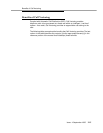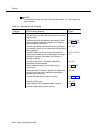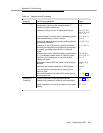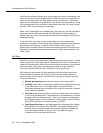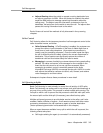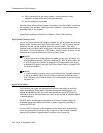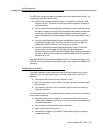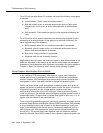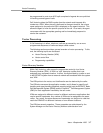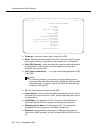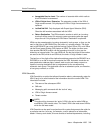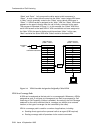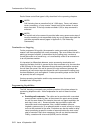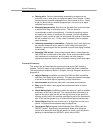
Fundamentals of Call Vectoring
3-6 Issue 4 September 1995
For a CO call, the caller hears CO ringback until one of the following vector steps
is reached:
■ Announcement (Caller hears the announcement.)
■ Wait with system music or alternate audio/music source (Caller hears
system music, or the music or audio associated with an administered
port.)
■ Call answered (Caller hears the agent or voice response answering the
call.)
For a CO call for which answer supervision has already been supplied (via the
processing of an announcement or the issuing of a
wait-time
command), the
caller may hear any of the following:
■ Announcement when any
announcement
command is processed.
■ Ringback, silence, system music, or an alternate audio/music source
when a
wait-time
command is processed.
■ Busy when a
busy
command is processed.
■ Ringback when the call is alerting a station.
Regardless of the call’s origin, the caller can expect to hear different forms of the
feedback described in this section as the relevant vector steps are processed.
Examples of how subsequent caller feedback is provided in the vector appear in
Chapter 4, "Basic Call Vectoring" and in several of the following chapters.
Dialed Number Identification Service (DNIS)
In the traditional ACD arrangement, each agent in a given split is trained to
answer calls relevant to one specific purpose in an efficient and professional
manner. However, ACD managers have recognized the need to enhance this
arrangement in which each split is limited to a single call-answering task.
To this end, there is now a split arrangement available in which each group of
agents is proficient in dealing with several types of calls. The intent is to service
multiple call types with the use of fewer agents overall and with less
administrative intervention by the ACD manager. Usual economies of scale
come into play here. For example, where five agents might be needed in each of
three smaller splits (15 agents total) to handle three types of calls, only 11 or 12
agents might be needed in the combined split.
To aid in providing capabilities such as the one just presented, a network service
known as Dialed Number Identification Service (DNIS) is available. DNIS enables
a unique multidigit number that is based on the dialed number (of usually four
digits) to be associated with the call (sent to a customer’s telephone, sent to a
host computer with ASAI applications, used to provide different treatments for
the call, etc.). The number that is sent depends upon the telephone number
dialed by the caller. Each DNIS number in the customer’s telephone system can



